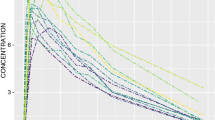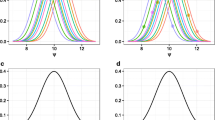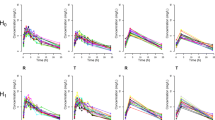Abstract
Sampling times for Bayesian estimation of the pharmacokinetic parameters of an antidepressant drug, nortriptyline, during its therapeutic drug monitoring were optimized. Our attention was focused on designs including a limited number of measurements: one, two, and three sample designs in which sampling times had to be chosen between 0 and 24 hr after the last intake of a test-dose study. The optimization was conducted in four groups of patients defined by their gender and the administration or not of concomitant drugs inhibiting the metabolism of nortriptyline. The Bayesian design criterion was defined as the expected information provided by an experiment. A stochastic approximation algorithm, the Kiefer–Wolfowitz algorithm, was used for the criterion maximization under experimental constraints. Results showed that optimal Bayesian sampling times differ between patients in monotherapy and polytherapy. For one-sample designs the measurements have to be performed either at the lower (0 hr) or at the upper (24 hr) bound of the admissible interval. Replications were often found for 2- and 3-point designs. Other sampling designs can lead to criterion close to the optimum and can therefore be performed without great loss of information. In contrast, we found that several designs lead to low values of the information criterion, which justifies the approach.
Similar content being viewed by others
REFERENCES
J. L. Steimer, M. E. Ebelin, and J. Van Bree. Pharmacokinetic and pharmacodynamic data and models in clinical trials. Eur. J. Drug. Metab. Pharmacokin. 18:61–76 (1993).
L. Yuh, S. Beal, M. Davidian, F. Harrisson, A. Hester, K. Kowalski, E. Vonesh, and R. Wolfinger. Population pharmacokinetics/pharmacodynamics methodology and applications: A bibliography. Biometrics 50:566–575 (1994).
M. Davidian and D. M. Giltininan. Non Linear Models for Repeated Measurement Data, Chapman and Hall, London, 1995.
K. Chaloner and I. Verdinelli. Bayesian experimental design: A review. Statist. Sci. 10:273–304 (1995).
D. V. Lindley. On the measure of information provided by an experiment. Ann. Math. Statist. 27:986–1005 (1956).
C. E. Shannon. A mathematical theory of communication. Bell System Tech. J. 27:379–423 (1948).
M. H. DeGroot. Uncertainty, information and sequential experiment. Ann. Math. Stat. 33:404–419 (1962).
J. M. Bernardo. Expected information as expected utility. Ann. Statist. 7:686–690 (1979).
N. G. Polson. On the expected amount of information from a non-linear model. J. Roy. Statist. Soc. B54:889–895 (1992).
D. Z. D'Argenio. Incorporating prior parameter uncertainty in the design of sampling schedules for pharmacokinetic parameter estimation experiments. Math. Biosci. 99:105–118 (1990).
M. Tod and J. M. Rocchisani. Implementation of OSPOP, an algorithm for the estimation of optimal sampling times in pharmacokinetics by the ED, EID and API criteria. Comput. Meth. Prog. Biomed. 50:13–22 (1996).
P. Mueller and G. Parmigiani. Numerical evaluation of information theoretic measure. Technical report 93A05, Duke University, Durham, NC, 1993.
P. Mueller and G. Parmigiani. Optimal design via curve fitting of Monte Carlo experiments. J. Am. Statist. Assoc. 90:1322–1333 (1995).
Y. Merlé and F. Mentré. Bayesian design criteria: computation, comparison and application to a pharmacokinetic and a pharmacodynamic model. J. Pharmacokin. Biopharm. 23:101–124 (1995).
J. Kiefer and J. Wolfowitz. Stochastic estimation of the maximum of a regression function. Ann. Math. Stat. 23:462–466 (1952).
Y. Merlé and F. Mentré. Stochastic optimization algorithms of a Bayesian design criterion for Bayesian parameter estimation of nonlinear regression models. Application in pharmacokinetics. Math. Biosci. 144:45–70 (1997).
M. Jerling, Y. Merlé, F. Mentré, and A. Mallet. Population pharmacokinetics of nortriptyline at monotherapy and during concomitant treatment with drugs that inhibit CYP2D6—an evaluation with the nonparametric maximum likelihood method. Br. J. Clin. Pharmacol. 38:453–462 (1994).
M. Asberg, B. Cronholm, F. Sjoqvist, and D. Tuck. Relationship between plasma level and therapeutic effect of nortriptyline. Br. Med. J. 3:331–334 (1971).
L. Bertilsson, M. Eichelbaum, B. Mellstrom, J. Sawe, H. U. Schultz, and F. Sjoqvist. Nortriptyline and antipyrine clearance in relation to debrisoquine hydroxylation in man. Life Sci. 27:1673–1677 (1980).
M. L. Dahl and L. Bertilsson. Genetically variable metabolism of antidepressants and neuroleptic drugs in man. Pharmacogenetics 3:61–70 (1993).
E. Steiner, L. Bertilsson, J. Sawe, I. Bertling, and F. Sjoqvist. Polymorphic debrisoquin hydroxylation in 757 swedish subjects. Clin. Pharmacol. Ther. 51:12–17 (1992).
M. L. Dahl, L. Bertilsson, and C. Nordin. Steady-state plasma levels of nortriptyline and its 10-hydroxymetabolite: Relationship to the CYP2D6 genotype. Psychopharmacologica 123:315–319 (1996).
B. Miljkovic, M. Pokrajac, I. Timotijevic, and V. Varagic. Clinical response and plasma concentrations of amitriptyline and its metabolite nortriptyline in depressive patients. Eur. J. Drug. Metab. Pharmacokin. 21:251–255 (1996).
N. M. K. Ying Kin, N. Klitgaard, N. P. V. Nair, M. Amin, P. Kragh-Sorensen, G. Schwartz, S. K. Ahmed, P. Holm, C. Katona, and K. Stage. Clinical relevance of serum nortriptyline and 10-hydroxy-nortriptyline in the depressed elderly: A pharmacokinetic and pharmacodynamic study. Neuropsychopharmacology 15:1–6 (1996).
A. Mallet. Maximum likelihood estimation method for random coefficient regression models. Biometrika 73:645–656 (1986).
L. Pronzato and L. E. Walter. Robust experiment design via stochastic approximation. Math. Biosci. 75:103–120 (1985).
Author information
Authors and Affiliations
Rights and permissions
About this article
Cite this article
Merlé, Y., Mentré, F. Optimal Sampling Times for Bayesian Estimation of the Pharmacokinetic Parameters of Nortriptyline During Therapeutic Drug Monitoring. J Pharmacokinet Pharmacodyn 27, 85–101 (1999). https://doi.org/10.1023/A:1020634813296
Published:
Issue Date:
DOI: https://doi.org/10.1023/A:1020634813296




